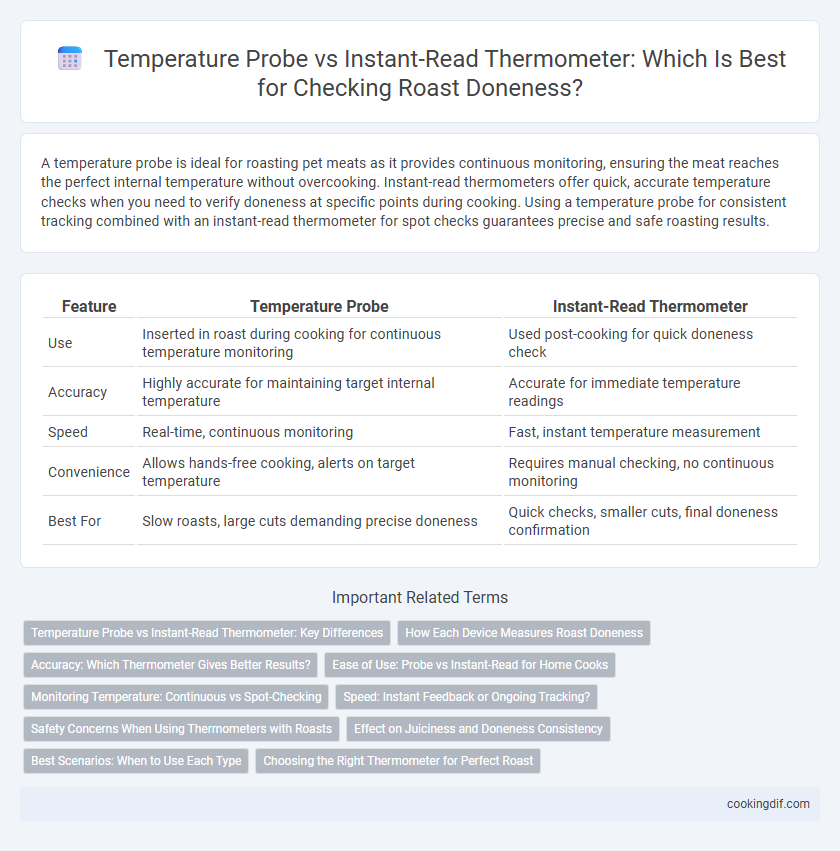A temperature probe is ideal for roasting pet meats as it provides continuous monitoring, ensuring the meat reaches the perfect internal temperature without overcooking. Instant-read thermometers offer quick, accurate temperature checks when you need to verify doneness at specific points during cooking. Using a temperature probe for consistent tracking combined with an instant-read thermometer for spot checks guarantees precise and safe roasting results.
Table of Comparison
| Feature | Temperature Probe | Instant-Read Thermometer |
|---|---|---|
| Use | Inserted in roast during cooking for continuous temperature monitoring | Used post-cooking for quick doneness check |
| Accuracy | Highly accurate for maintaining target internal temperature | Accurate for immediate temperature readings |
| Speed | Real-time, continuous monitoring | Fast, instant temperature measurement |
| Convenience | Allows hands-free cooking, alerts on target temperature | Requires manual checking, no continuous monitoring |
| Best For | Slow roasts, large cuts demanding precise doneness | Quick checks, smaller cuts, final doneness confirmation |
Temperature Probe vs Instant-Read Thermometer: Key Differences
A temperature probe provides continuous internal temperature monitoring during roasting, allowing precise control over doneness without opening the oven. An instant-read thermometer delivers quick spot checks by inserting the device for a few seconds, ideal for verifying final temperature when the roast is near completion. Temperature probes are better for gradual cooking processes, while instant-read thermometers excel in providing rapid accuracy for final doneness verification.
How Each Device Measures Roast Doneness
A temperature probe measures roast doneness by continuously monitoring the internal temperature, allowing precise control during cooking. An instant-read thermometer provides a quick spot-check by inserting the device into the meat and displaying the current temperature almost immediately. Both tools rely on accurate temperature readings, but the probe enables real-time adjustments while the instant-read confirms final doneness.
Accuracy: Which Thermometer Gives Better Results?
Temperature probes provide continuous, accurate temperature monitoring throughout the roasting process, ensuring precise doneness by measuring internal meat temperatures at various depths. Instant-read thermometers offer quick, momentary temperature checks but may lack consistency and require multiple insertions, potentially causing heat loss and uneven results. For superior accuracy and optimal roast outcomes, temperature probes are generally preferred due to their ability to deliver real-time, reliable data.
Ease of Use: Probe vs Instant-Read for Home Cooks
Temperature probes offer continuous monitoring by staying in the roast throughout cooking, simplifying the process for home cooks who prefer hands-off methods. Instant-read thermometers require manual insertion and quick readings, providing precise spot checks but demanding more attention during cooking. For ease of use, probes minimize guesswork and interruptions, making them ideal for consistent doneness without frequent checking.
Monitoring Temperature: Continuous vs Spot-Checking
Temperature probes provide continuous monitoring by remaining inserted in the roast throughout cooking, allowing precise control over internal temperature and preventing overcooking. Instant-read thermometers offer spot-checking capability, delivering quick temperature readings at specific moments but requiring the oven to be opened multiple times. For consistent doneness and minimal heat loss, temperature probes are more reliable, especially in slow-roasting methods.
Speed: Instant Feedback or Ongoing Tracking?
An instant-read thermometer provides rapid temperature readings within seconds, ideal for quick doneness checks without interrupting the cooking process. A temperature probe, inserted into the roast, offers continuous monitoring and alerts when the target temperature is reached, ensuring precise control over cooking progress. Choosing between these tools depends on whether you prioritize immediate feedback or ongoing temperature tracking during roasting.
Safety Concerns When Using Thermometers with Roasts
Using a temperature probe for roasts ensures continuous internal monitoring, reducing the risk of undercooking and bacterial survival. Instant-read thermometers provide quick doneness checks but require frequent insertion, increasing cross-contamination risks if not sanitized properly. Proper calibration and hygiene practices are essential to maintain food safety when using any thermometer with roasts.
Effect on Juiciness and Doneness Consistency
A temperature probe ensures consistent doneness by continuously monitoring internal roast temperature, preventing overcooking and preserving juiciness through precise heat control. Instant-read thermometers provide a quick temperature check but risk heat loss from repeated insertion, potentially causing uneven cooking and reduced moisture retention. Using a probe promotes optimal juiciness and uniform doneness by maintaining steady internal temperatures throughout the roasting process.
Best Scenarios: When to Use Each Type
A temperature probe excels in monitoring roast doneness during long cooking processes by providing continuous, real-time internal temperature readings without opening the oven, ideal for slow roasts and whole poultry. Instant-read thermometers deliver quick, accurate temperature checks when precise doneness verification is needed just before serving or during shorter cooking times, best suited for steaks and smaller cuts. Choosing between these depends on cooking duration and the need for temperature monitoring frequency to achieve perfectly cooked roasts.
Choosing the Right Thermometer for Perfect Roast
Selecting the right thermometer is crucial for achieving the perfect roast, with temperature probes offering continuous monitoring and instant-read thermometers providing quick, precise readings at key doneness points. A temperature probe ensures even cooking by staying inserted throughout the roasting process, ideal for larger cuts like prime rib or whole chicken. Instant-read thermometers excel when checking various spots rapidly, making them perfect for smaller roasts or when verifying internal temperature just before serving.
Temperature probe vs instant-read thermometer for doneness Infographic

 cookingdif.com
cookingdif.com